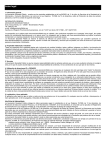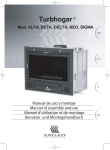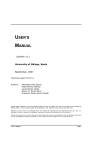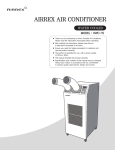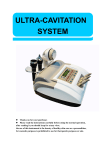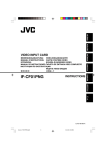Download IPC 307 Instruciones 1 en
Transcript
General specifications Servicing and Cleaning Model: Wipe the case with a damp cloth and mild detergent. Do not use abrasives or solvents. Dirt or moisture in the terminals can affect safe use and correct functioning. Input Voltage: 3 phase to phase inputs L1, L2 & L3 : 440 V AC max. 600V DC max If the IPC or connecting leads are damaged, then the IPC will need to be replaced. DC BUS Voltage: 280 - 600V DC Verify the IPC operation by momentarily connecting a known 230VAC voltage to each combination of phase pairs until, all 6 Indicators have been illuminated. Phase load: 8.5 mA maximum per phase. The battery can be tested by holding the MEM button for 4 seconds: If 6 LEDs light, then the batteries are good. Carrier Frequency: 5 to 20Khz. Use only alkaline batteries. Operating Environment: 0 °C to 40 °C at < 80 % R.H. If storing for long periods remove batteries - in case of leakage. Indoor and dry outdoor. IP40. Altitude: 2000 m (6561 ft.) max. IPC-307 Power: 2 x 1.5V LR6, AA Alkaline Battery Only. Accessaries Part Number Description IP 01-1020 Set of 3 Crocodile Clips. IP 01-1030 Set of 3 Retractable Hook Probes. IP 01-1040 Set of 3 Insulation Piercing Probes. Dimensions: Enclosure 119(L) x 79(W) x 24(D) mm. Inverter Phase Checker Connection Leads: 500mm, 4mm shrouded banana connectors. Weight: 250g (with standard probes). Overload protection 500V ac 10 seconds. CAT II, 600V, Pollution degree 2, Class 2. This meter meets CAT II IEC 61010 standards. The IEC 61010 safety standard defines four measurement categories (CAT I to IV) based on the magnitude of danger from transient impulses. CAT II meters are designed to protect against transients in energy consuming equipment supplied from fixed installation. Warning: Important Information; read instructions Warning: Hazardous Voltages Alternating Current Direct Current Double Insulated Conforms to European Union directives This Guide contains instructions for using the Inverter Phase Checker. Refer to the manufacturer’s service manual of the air conditioning equipment for further safety and servicing information. Safety Technical Assistance Warning. Read before using the IPC-307 n Warning identifies hazardous conditions and actions that could cause bodily harm or death. n The IPC-307 is intended to be used only on airconditioning, heat-pump and refrigeration based inverter systems only. Do not connect to power distribution or supply lines (U, V, W). n Use only as specified in this manual or the protection provided by the IPC might be impaired. n In order to obtain a correct diagnosis, tests must be made on electrically live parts. Such measurements must be made by properly trained professional persons, familiar with the hazards involved. n When using the test leads, keep your fingers behind the finger guards. n Do not allow conductors of probes to come into contact with other components or any part of the case or metal parts. n Do not make or disconnect circuits while live. This is dangerous and may cause permanent damage to components. n The IPC has a strong magnetic base for mounting conveniently on to steel condenser housings. The engineer must be sure the mounting is secure before powering up. n Protect the Inverter Checker against water, moisture, condensation and precipitation. n If the IPC or connecting leads are damaged, they must be replaced. n Do not apply more than the rated voltage, as marked on the IPC. n No serviceable parts inside. Do not open the IPC Casing. Operate only with battery cover fitted. n Limit the time the IPC is connected to outputs of continuous activity to 10 minutes. Rest for 10 minutes before repeat test. MPS ADVANCE ELECTRONIC TECHNOLOGY, S.L. Urb. La Vista C/ Trébol, 4-6, E-29639 Benalmádena (Málaga) España. Tel: + 34 952 56 56 88, [email protected], www.mpsaet.com Testing. Inverter Information. Warning. The inverter uses a rectifier to convert the incoming alternating current (AC) to direct current (DC) and then switches the 6 transistors in a sequence to produce AC of a desired frequency. The variable frequency AC drives the compressor. When an inverter system starts up - It is common for there to be a delay of typically two to three minutes before the output is enabled and the duration of the output switching sequence that follows, may only last for a second or more. To avoid electric shock or injury, or damage to the IPC, always disconnect power supplies before making or disconnecting connections. Wait three minutes for stored charge in capacitors (DC Voltage) to safely discharge. The sequence is terminated once the inverter senses there is no compressor loading. This Inverter Phase test must be carried out with the compressor disconnected from the Inverter Board. 4 In some cases the phase sequence might be repeated following a further delay. Also, following a fault, some systems will require a resetting action of some kind. 3 PHASE INVERTER + + + Disconnect the 3 phases supplying the compressor. 4 4 Connect L1, L2 and L3 of the IPC to the 3 phases output from the inverter board ( sometimes designated U, V, W). There are various ways of connecting the Inverter Phase Checker, depending on the type and accessibility of the terminals. The Engineer must ensure that suitable and secure connections are correctly made before switch on. After all connections are safely made, switch on the power. + 4 Clear the IPC-307 memory and check battery condition by pressing and holding the MEM switch for 4 seconds until a beep is heard. The 6 LEDS will light in sequence. Release the switch. L2 (V) L1 (U) 4 Configure the system to call for cooling L3 (W) - AC IN RECTIFIDC CATION VOLTAGE - 4 As soon as the inverter initiates a start up sequence, corresponding LEDs will blink in a sequence (not indicative of rotation direction) and an audible beep will sound .Normally this only occurs for a second or so. The IPC will notify of a start up sequence having been detected by sounding a single short audible beep every 4 seconds, corresponding LEDs will flash indicative of valid signals sensed.. - OUTPUT TRANSISTORS AC MOTOR 4 Press the MEM button to recall test result. All 6 LEDs must light. Hold MEM to clear memory for re-testing. If one or more LEDs are not lit, check probe connections and repeat test. Introduction to the IPC-307 The IPC functions to identify inverter faults when a problem arises such as compressor over-current protection and shut down. It senses and measures valid switching operation of the 6 output transistors in inverter systems. A sequence in which all 6 transistors switch both on and off, is indicative of correct operation. The IPC is connected to the inverter instead of the compressor and automatically monitors the inverter output. Battery Powered The IPC remains in standby mode and will start automatically when inverter activity is sensed on the L1,2 & 3 inputs, or when the MEM button is pressed. Conclusion Correct Function Inverter Outputs : all 6 LEDs must light. Faulty Output: one, more or all of the LEDs do not light. Faulty Output: one or more LEDs are constantly on. If any or all of the outputs are not functioning properly, then the Invertor board (or IPM) will need to be replaced. Virtually no power is consumed while in standby. The battery can be tested by holding the MEM button for 4 seconds: If 6 LEDs light, then the batteries are good. When testing is complete, clear memory to put the IPC into standby mode and save battery power. Operation The IPC will record and display any valid signals it detects with LED and an audible beep. Valid signals are recorded in memory and will remain until cleared. Following 4 seconds of no activity, the IPC will notify of a start up sequence having been detected by sounding a single short audible beep every 4 seconds. Corresponding LEDs will flash indicative of valid signals sensed. This will continue for 18 minutes, after which the memory will be cleared and the IPC enters standby mode. Memory Inverter start up sequences are often very short in duration - only a second or more. So the IPC stores valid signals in memory for later observation. Memory is recalled at any time by momentarily pressing the MEM button to display which signals have been detected. All 6 LEDs constantly lit indicated a test pass. Holding the MEM switch for 4 seconds or longer will clear memory and place the IPC in standby mode. The memory must be cleared before initiating any test or repeat test. Magnetic Base The IPC-307 has a strong magnetic base for mounting conveniently on to steel condenser housings. Compressors. Compressors can fail with insulation breakdown between motor windings or down to earth. It is advised to carry out an electrical insulation test to earth and a resistance test between each winding of the compressor, in accordance with manufacturer’s data, prior to reconnecting. Example of connecting the IPC-307 to the Inverter Compressor feed Terminals 2 Year Warranty: This product has been fully tested and is certified to be free of any faults. Provided it is operated, transported and stored in a professional manner and in accordance with the instructions it will give long and reliable service. If any fault develops check first the servicing section of this leaflet. If the product fails within 2 years of purchase, due to a defect in either materials or manufacture, it will be replaced or repaired by the manufacturer, provided it can be clearly shown that it has been operated, maintained and used as shown in the instructions. No liability can be accepted under any circumstances for any indirect, incidental or consequential damages or losses, including data, arising from the use of this product. This warranty does not cover batteries, damage from neglect, misuse, contamination, alteration, accident or abnormal conditions of operation or handling, including failures caused by use outside of the product’s specifications, or normal wear and tear of mechanical components. Warranty will be void with evidence into opening or tampering with the casings. This warranty covers the original purchaser only and is not transferable.






